Organizations seeking alternatives to VMware can look to VergeIO, which offers a high-performance, software-defined infrastructure that eliminates expensive add-ons. Where most infrastructure software is built from multiple separate applications wrapped behind a GUI, VergeIO is unique in its integration of virtualization, storage services, and networking into a single piece of software. The result is simplified operations and maximum hardware efficiency.
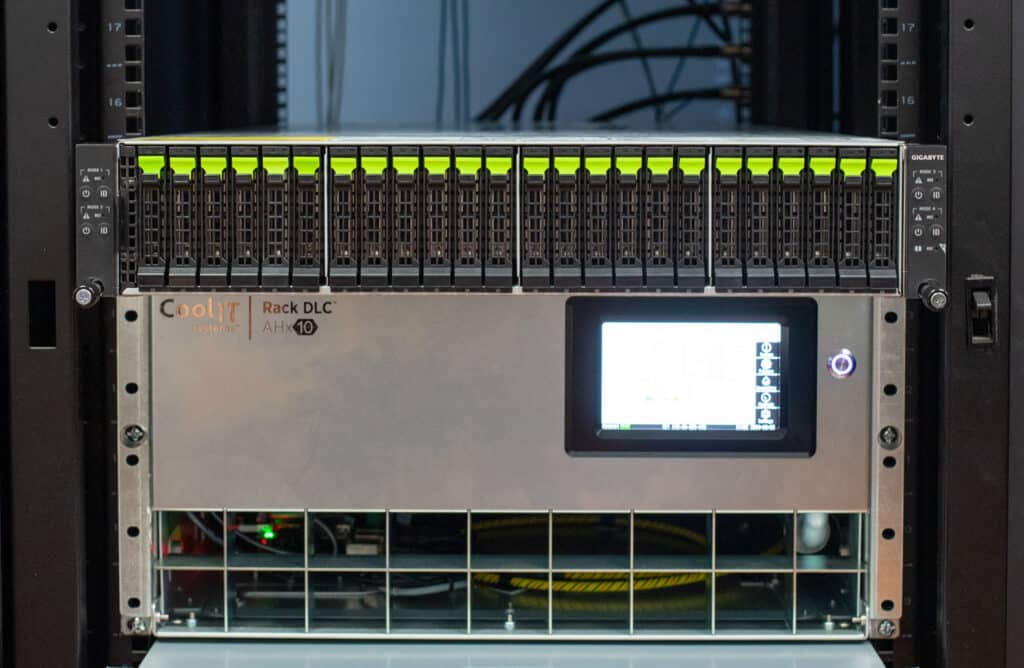
We first looked at Verge.io almost two years ago, highlighting the need for hyperconverged alternatives given the uncertainty around Broadcom’s licensing plans for VMware. Since then, the VMware pricing model has become reasonably clear. Large organizations that use most of VMware’s features will likely continue, but a vast swath of the enterprise and small business market will need an alternative.
In the complex world of enterprise virtualization, licensing often becomes a labyrinth of confusion and unexpected costs. VergeIO’s licensing model starkly contrasts VMware, Windows Server, and Nutanix. At the same time, these competitors employ intricate licensing schemes based on cores, processors, or feature sets. Customers can configure quad-processor servers with one hundred-plus cores without having to explain why the software is twice as expensive as the hardware. VergeIO opts for simplicity. VergeIO employs a per-node licensing model and, as previously mentioned, includes all features in its base license. This means access to advanced storage tiering, disaster recovery, and other enterprise-grade features without additional licensing fees. All while being 50% cheaper than VMWare.
We’ve set up an All-Star kit in the Cincinnati Lab to evaluate VergeIO’s cluster. Our goal is to assess its features, functionality, and performance. This evaluation also highlights modern infrastructure trends. We’re using dense liquid-cooled nodes from Giga Computing. These nodes feature high-performance, dense flash storage from Solidigm. To ensure compute performance isn’t a problem, we have high-core AMD EPYC 9554 64-core CPUs, 512GB DDR5, and dual-port 100GbE NVIDIA NICs.
VergeIO Benefits
VergeOS, the cornerstone of VergeIO’s offering, represents what they call Ultraconverged Infrastructure. Unlike VMware’s suite of products, VergeOS handles networking, storage, and compute in one comprehensive package. This unified approach allows for simplified administration and licensing. VergeIO aggressively positions itself as a VMware replacement, a strategy reflected in its product offerings.
Consider a scenario many enterprises might find familiar: You’re a large corporation currently utilizing the VMware stack, but the renewal quotes have given you sticker shock. As you contemplate alternatives, VergeIO emerges as a potential solution.
VergeIO offers one of the most comprehensive feature sets in the industry. It can be compared to leading solutions such as Nutanix and HyperV. In addition, it includes some notable features. We particularly liked the Storage Tiering functionality. Furthermore, in our testing, VergeIO’s migration implementation was the simplest and smoothest.
VergeOS supports native WireGuard integration for remote access. This can be configured for internal access within the hypervisor networks or for external networks to access any resources in your infrastructure. The seamless implementation adds a layer of security and flexibility that many IT administrators will appreciate.
Another noteworthy feature is VergeIO’s Catalog, which resembles XenOrchestra’s Hub. The Catalog includes various cloud-init configurations for one-click VM deployment, streamlining the process of spinning up new instances. Additionally, it allows for the creation of VM recipes and repositories. Combined with VergeIO’s Terraform Provider, these features can significantly accelerate orchestration processes.

VergeIO is not just about convenience. Maintaining high SLAs is crucial for enterprise-grade virtualization. VergeOS is feature-complete, supporting high availability and live migration, allowing VMs to migrate between nodes within a cluster.
Regardless, Disaster Recovery is where VergeIO truly excels. Firstly, VergeOS enables independent snapshots that act like clones. These snapshots aren’t dependent on previous clones, allowing for greater performance. This is thanks to their IOClone, which deduplicates on the fly. Moreover, VergeIO takes it a step further. They encapsulate the entire data center within their multi-tenant virtual data center (VDC), allowing for replication and management of the data center as a single object.
When paired with IOGuardian, VergeIO offers near real-time replication (with intervals as low as 15 minutes). This replication process also incorporates inline deduplication to ensure maximum drive utilization. The replication includes a complete replica of the original data center, including all configuration details. This ensures functionality even on different hardware setups. Additionally, VergeIO allows leveraging IOGuardian replication for rapid recovery of replaced drives. These features enable users to implement a 3-2-1 backup strategy entirely within the VergeOS environment.
VergeIO’s approach to system updates also helps maintain high SLAs. First, VergeOS operates on a quarterly update cycle, which ensures each release is mature and thoroughly tested. Second, updates are scheduled for automatic application. The system intelligently manages this process by migrating VMs and applying updates to one host at a time under maintenance mode. Each update has a system snapshot with a 12-hour lifetime for easy rollback.
VM Migration
As customers consider VMware alternatives, migrating to a new platform is a critical concern. Migration begins with a remarkably speedy initial setup of the VergeIO cluster with VSAN (this differs from VMware’s vSAN). What’s truly impressive is the migration itself, which can be completed in minutes.

The VergeIO dashboard features a Backup/DR tab that allows direct connection to your vCenter or ESXi using their native APIs. This functionality lets you view your VMware VMs and select which ones to copy. The system initiates a sync process, ensuring your VMs are periodically updated.

Once the sync is established, you can start the VMs automatically converted during this process. At this stage, VergeIO offers the flexibility to select your preferred storage tiers (a feature we’ll delve into later) and retain your MAC addresses for existing DHCP reservations. The ongoing sync process ensures your VMs remain up-to-date until you’ve completed testing and are ready to migrate fully, allowing you to confidently remove the VMs from your VMware environment.
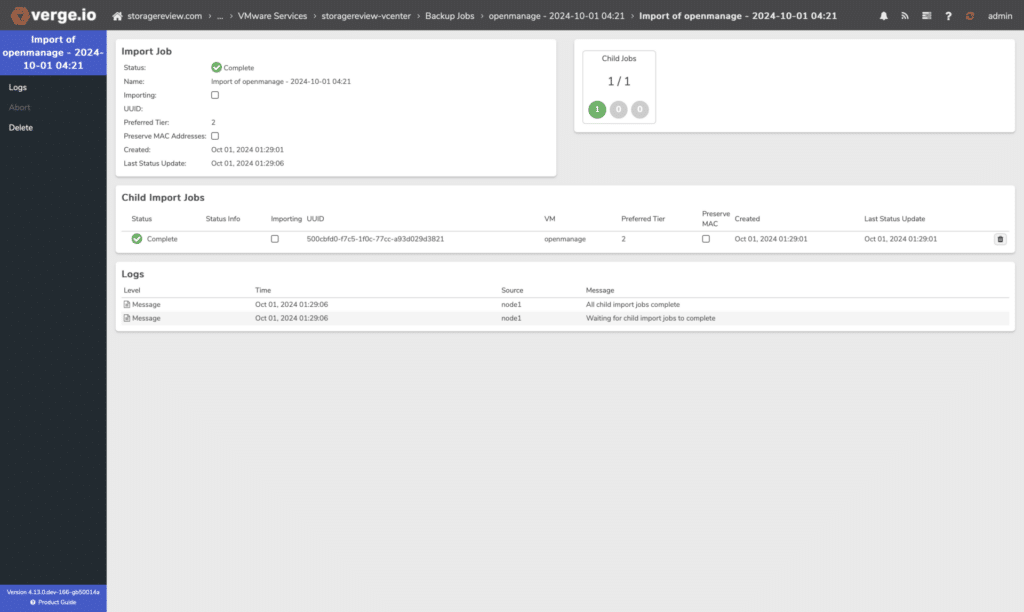
With your VMs now running on VergeOS, a world of possibilities opens up for management. The platform allows for creating sites, tenants, clusters, and data centers, enabling the virtual segmentation of resources. Administrators can finely control user access, permitting them to manage specific resource sets. Similar to vCenter, the system meticulously logs all actions. VergeIO takes security further by offering the option to password-protect the console, adding an extra layer of protection, and offering OIDC integration for SSO authentication.
VergeIO VSAN and Storage Tiering
One of VergeOS’s standout features is its Storage Tiering capability. VergeOS allows users to store data on various types of media based on performance, availability, and recovery requirements. The system seamlessly integrates all of this into its vSAN. Importantly, VergeIO makes it available in the base VergeOS with a single license and no additional charge for capacity consumed—a stark contrast to VMware’s multiple licensing tiers.
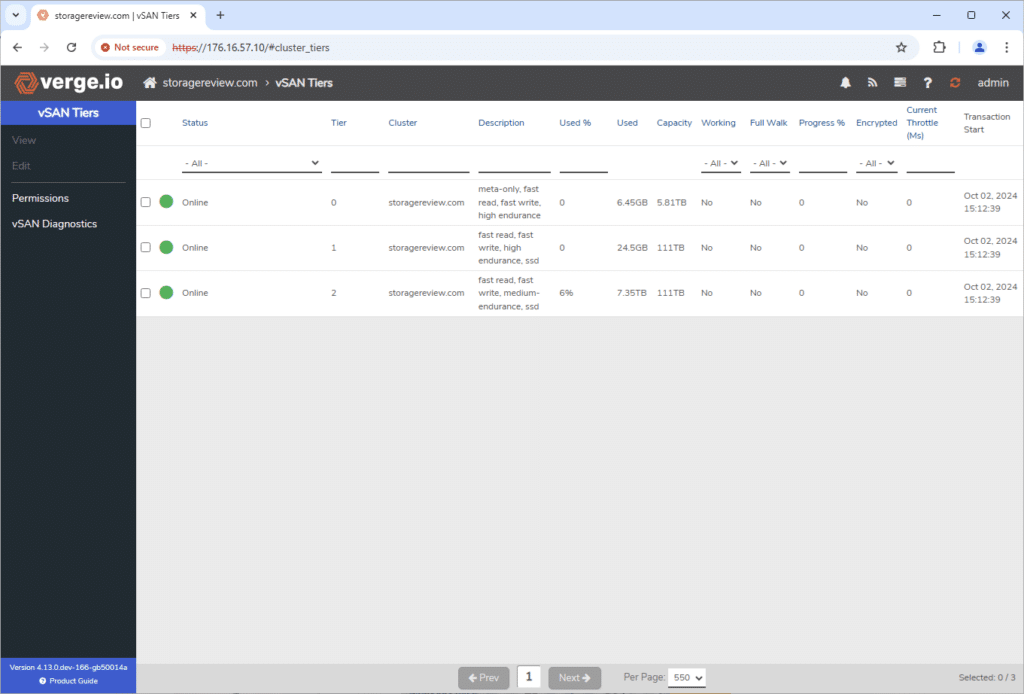
The platform we leveraged for this VergeIO HCI build offered 24 2.5″ NVMe bays, with six available per node. Two nodes required meta-data disks, giving us five remaining slots for matching SSDs to build out the storage tiers. VergeIO is very flexible when handling different types of storage devices, so we created two storage pools with Solidigm SSDs. While not used for storage capacity, VergeIO uses a metadata tier that stores the logs for data reduction index tracking. It is recommended that the tier be built around multi-drive write-per-day SSDs.
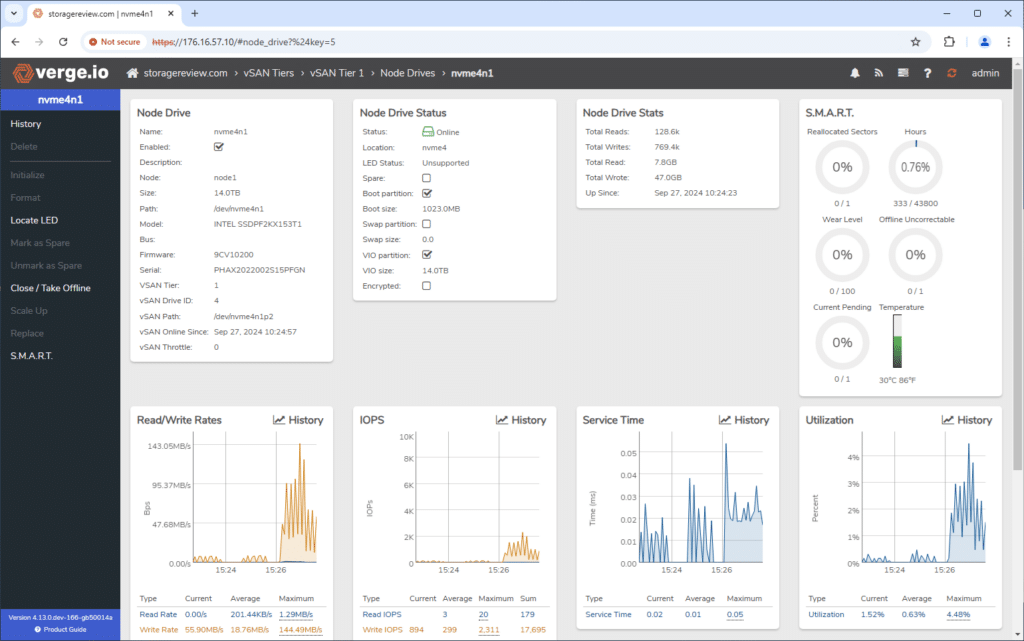
For tier 1, we used 16x Solidigm 15.36TB P5520 SSDs, which are 1DWPD SSDs, giving us a total storage capacity of 111.7TB. For tier 2, we used the Solidigm 61.44TB SSD, with each node getting a single SSD. This also worked out to be the same 111.7TB of storage capacity as the drives were 4x the capacity of the P5520 SSDs. It’s important to note that the usable storage capacity of the VergeIO platform will be even more significant as it offers inline global data deduplication. For the metadata tier 0, only two SSDs were required for mirrored redundancy. We used Solidigm P5620 6.4TB SSDs installed in nodes 1 and 2.
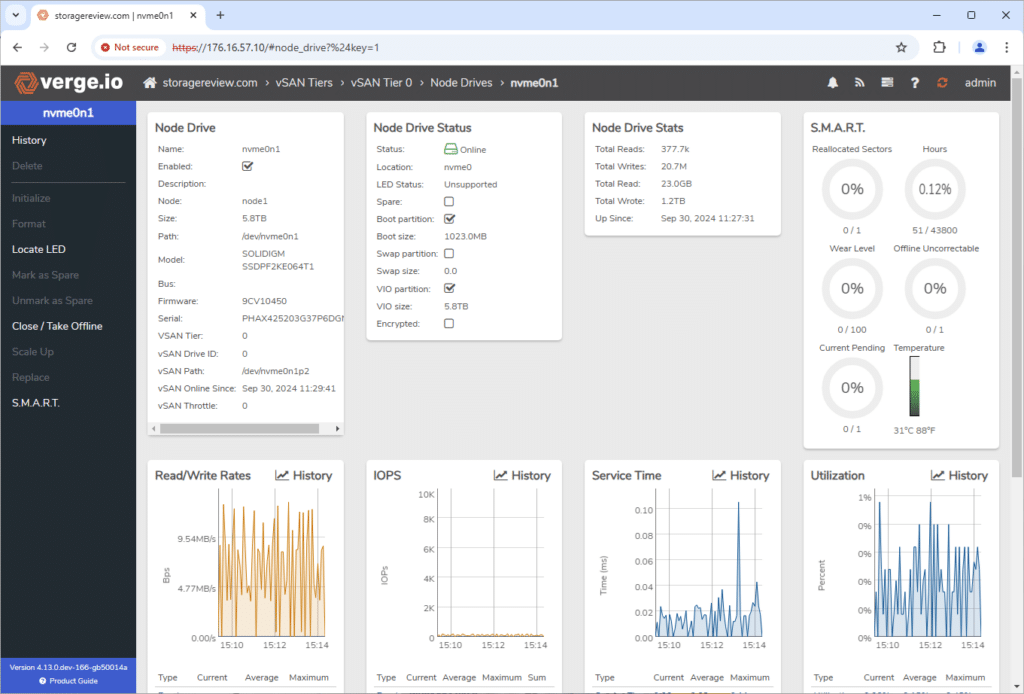
The Solidigm portfolio offers a wide range of SSDs to cover many different use cases. For many systems, the type of SSD, be it Gen4 or Gen5, might be a deciding factor, while others might focus on the drive shape: U.2, E1.S, or E3.S. Drive endurance also plays a massive role in terms of the NAND type leveraged inside the SSD model lines. For customers looking to deploy a VergeIO cluster, Solidigm offers products for each tier, making it easy to be a one-stop shop for flash storage.
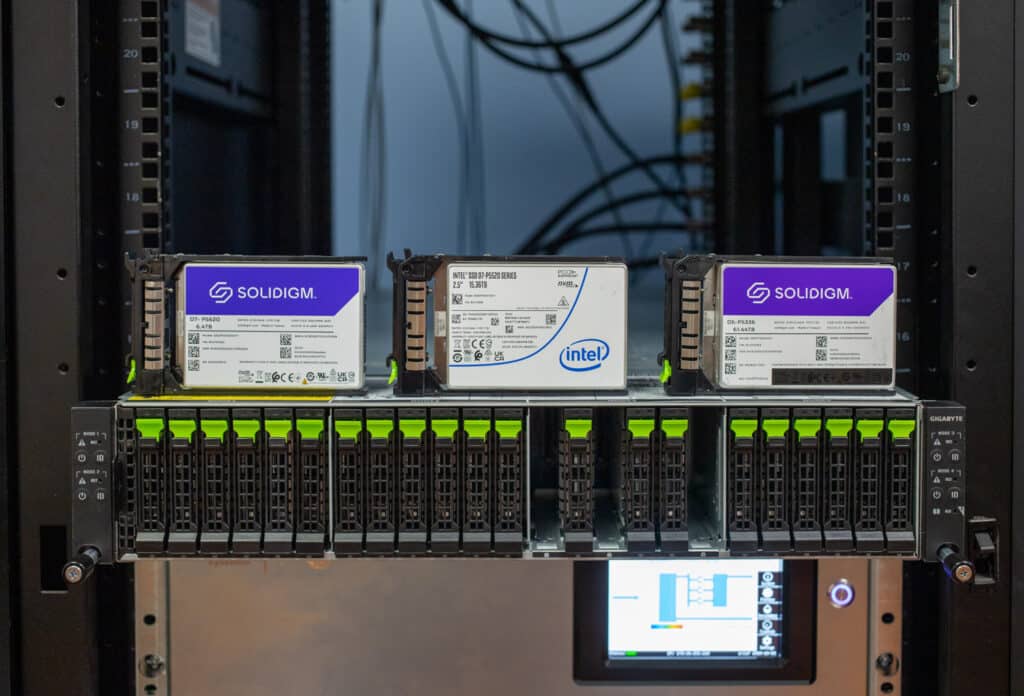
Data density plays a massive role in storage solutions. If you want to take advantage of the highest capacity SSDs on the market, such as the Solidigm 61.44TB P5336, the storage system must be compatible with its 4K native block size. Customers can use QLC media for large data footprints, such as our build, where we only used four drives to get 111TB. VMware does not currently support QLC, limiting customers’ platform density and the ability to select the drives they may want.

Test Platform – GIGABYTE H273-Z80-LAW1
To evaluate VergeIO’s performance, we brought several leading partners to bring the cluster to life. We assembled a cutting-edge hardware configuration emphasizing density and efficiency—two key trends in modern data centers. At the core of our test cluster is the GIGABYTE H273-Z80-LAW1, a dense liquid-cooled 4N2U server that perfectly aligns with these objectives.
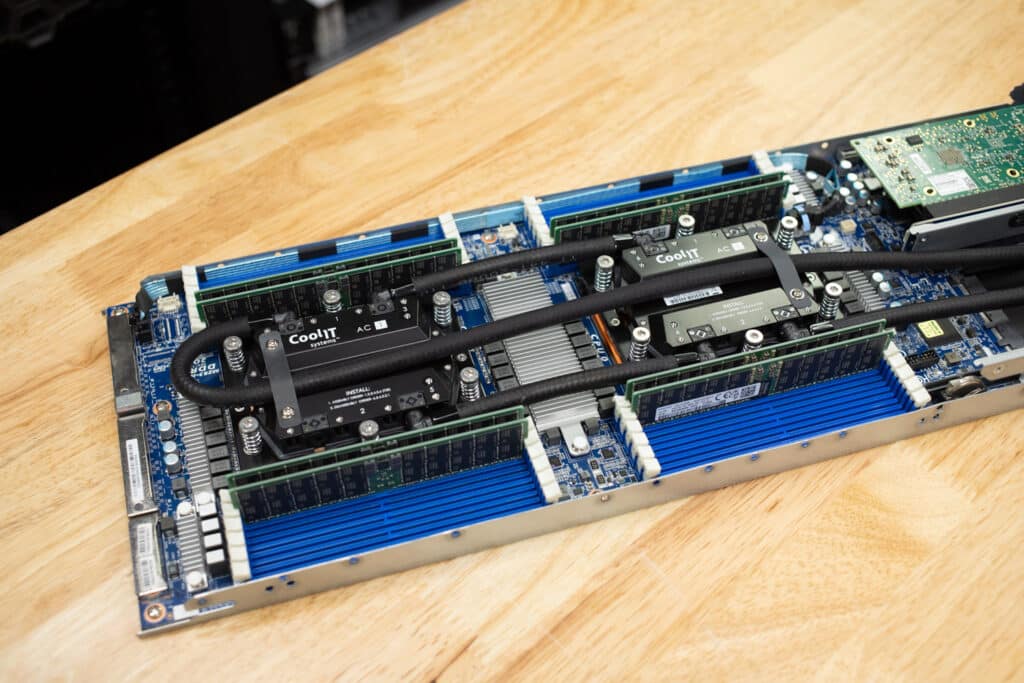
The H273-Z80-LAW1 is an impressive server, offering up to 1024 cores and 48TB of RAM. Our specific setup includes eight AMD EPYC 9554 64-core processors and 2TB of DDR5 memory, providing a robust foundation for our VergeIO cluster.
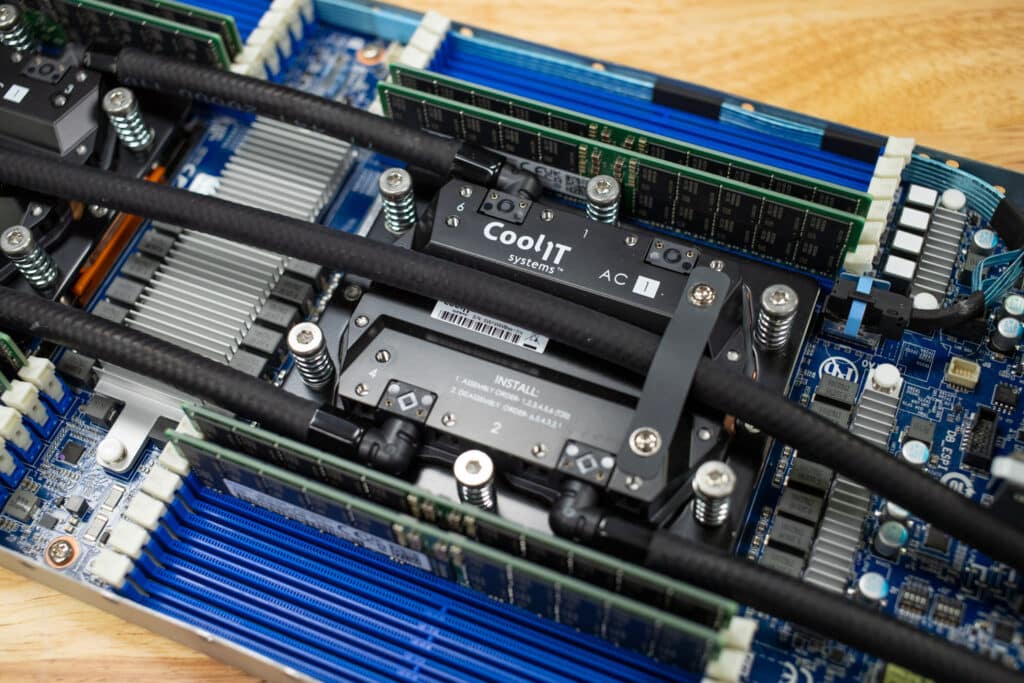
This impressive density is enabled by Giga Computing’s partnership with CoolIT, bringing liquid cooling into play. The system aligns perfectly with our existing CoolIT CDU and manifold setup, a configuration that’s becoming increasingly crucial in modern data centers. This direct liquid cooling solution is not just about enhancing performance; it’s necessary to support the thermal demands of today’s high-powered CPUs, GPUs, and Dense HPC server configurations.
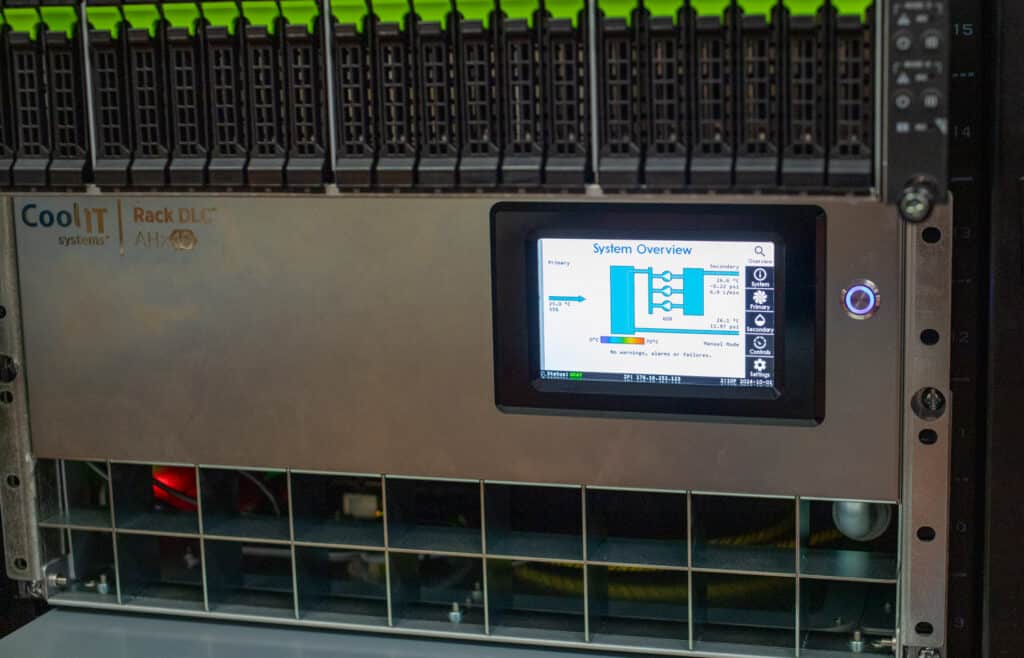
Our previous experiences with similar setups have shown significant power consumption, CPU temperature reductions, and modest performance improvements due to reduced thermal throttling. The CoolIT system’s efficiency and ease of use make it an ideal choice for high-density computing environments.
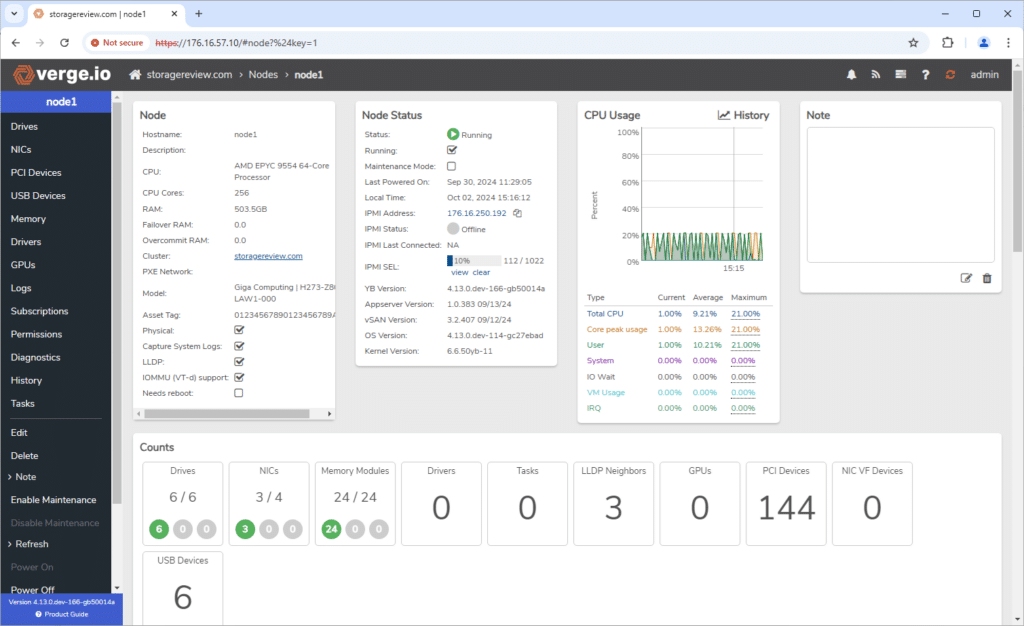
Each node in the H273-Z80-LAW1 supports up to 6 U.2 NVMe/SAS/SATA drives, totaling 24 drives across the server. As noted above, we’re incorporating three tiers of Solidigm flash storage, allowing us to test VergeIO’s ability to optimize data placement based on performance requirements. The server also features high-speed PCIe Gen 5 slots for networking and expansion, ensuring top-notch connectivity for our HCI environment.

Apart from the high density and impressive expansion for its size, one of the standout features of the H273-Z80-LAW1 is its Centralized Management Controller (CMC). This integrated solution simplifies the management of all four nodes, providing a single control point for the entire server. The CMC supports IPMI 2.0 and Redfish APIs, offering flexible remote management and monitoring options.
VergeIO Performance
To measure the performance of the VergeIO platform, we deployed 16 VMs (distributed 4 per node) to measure the aggregate performance of this HCI cluster. These VMs were used to orchestrate a Vdbench workload running evenly across the cluster, all reporting back to one VM. These Vdbench sessions were also set up to test with incompressible data to see how the cluster performed in a worst-case scenario as they support data reduction. Regarding data footprint, each VM had a 500GB data disk, stressing 8TB in total across the cluster.
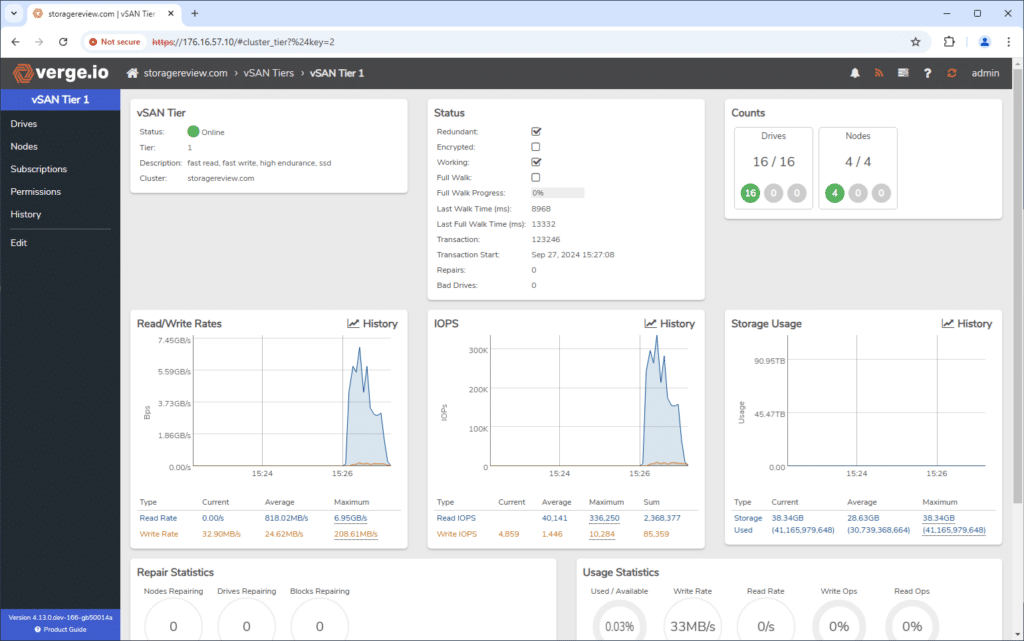
We focused on four-corner performance as well as a synthetic database performance using the following workloads:
- 2MB Sequential Read and Write
- 4K Random Read and Write
- SQL Workload
Regarding peak sequential bandwidth, we measured 4.7GB/s read to our TLC tier and 4.2GB/s to the QLC tier. Switching to write bandwidth, the TLC tier measured 6.9GB/s while the QLC tier measured 5GB/s.
| Vdbench Workload | VergeIO Tier 1 Solidigm TLC | VergeIO Tier 2 Solidigm QLC |
|---|---|---|
| 2MB Sequential Read | 4.7GB/s (27ms) | 4.2GB/s (30ms) |
| 2MB Sequential Write | 6.9GB/s (17.6ms) | 5.0GB/s (21.5ms) |
| 4K Random Read | 215MB/s (2.6ms) | 243MB/s (8.2ms) |
| 4K Random Write | 263MB/s (0.96ms) | 200MBs (0.85ms) |
| SQL | 533MB/s (0.89ms) | 525MB/s (0.97ms) |
VergeIO VSAN demonstrates impressive performance across workloads on Solidigm TLC and QLC storage tiers. Sequential operations show excellent throughput, with the TLC tier reaching 6.9GB/s for writes and 4.7GB/s for reads. Random I/O performance is respectable, with both tiers achieving over 200MB/s for 4K operations. Notably, the platform excels in SQL and VDI boot workloads, maintaining sub-millisecond latencies and high throughput.
These results indicate that the Solidigm SSDs had no difficulty keeping pace with the storage tiers integrated into our platform, with networking and platform constraints being the primary limiting factors instead of the drives themselves. VergeIO’s ultra-converged infrastructure can effectively support a wide range of enterprise applications, from large file transfers to database operations and virtual desktop environments, with the TLC tier generally offering higher performance for write-intensive scenarios.
VDI Performance
With VDI being a common workload deployed on VergeIO platforms, we wanted to test an extreme bootstorm to see how the cluster fairs with 1000 VMs spinning up simultaneously. Each VM had 2 CPUs, 2GB of RAM, and a 10GB disk. VM had a standard install of Ubuntu 22.04 (not minimal) to represent a real-world image. Once fully booted, a script is called via systemd that uses curl to send its mac and timestamp via HTTP to a remote collector.
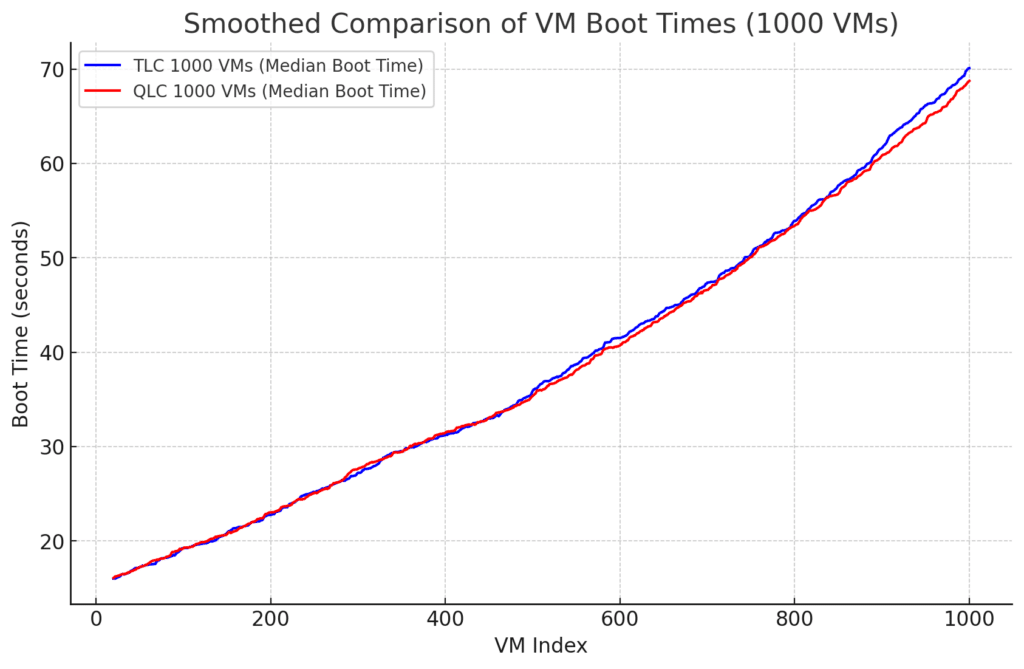
Our tests revealed that TLC and QLC offered very similar final performance. Looking at the backend storage data, the TLC SSDs did have an edge in total IOPS, although for this platform, the CPUs became the bottleneck before the storage did. All 1000 VMs were able to boot in around 71 seconds. These results highlight the benefits of mixing various SSDs in the VergeIO platform. Customers can easily use QLC storage for VDI tasks, which, in this case, allows for fantastic density and cost-effectiveness.
We also tested High Availability. We measured 138 seconds for the VM to become available following a complete loss of a node, which is roughly in line with what VergeIO claims.
Conclusion
VergeIO stands out as an excellent alternative to VMWare. Its comprehensive wiki and user-friendly migration process make it an attractive option for organizations considering a change. The simplified per-node licensing model, which is, on average, 50% cheaper than VMWare, makes it easier for decision-makers to evaluate and adopt.
The converged management also makes it one of the easier platforms to manage. At the same time, features like the Catalog and native Wireguard integration enhance the overall package, the platform’s robust performance, and meticulous attention to disaster recovery, which is truly impressive.
The polished nature of VergeIO’s platform elevates it above alternatives like Proxmox. We can easily recommend VergeIO to anyone seeking a hypervisor solution. It offers a robust, feature-rich environment suitable for organizations of all sizes. VergeIO successfully combines ease of use, strong performance, and enterprise-grade capabilities, making it a top-tier choice in the virtualization landscape.
This report is sponsored by VergeIO. All views and opinions expressed in this report are based on our unbiased view of the product(s) under consideration.




 Amazon
Amazon